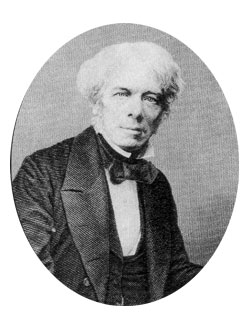
|
To omit the mention of Humphry Davy from any discussion of Michael Faraday’s (1791-1867) contribution to electrochemistry would be to omit and essential element of a key equation. Davy was Faraday’s mentor in his early years of physics and electrochemistry research. For a time, in fact, Faraday extended and developed the research begun by Davy at the Royal Institution in London, where Faraday began his career in 1813 as Davy’s Laboratory Assistant. Most of Faraday’s early experiments – and published papers - bore the stamp of Davy’s involvement. Faraday achieved scientific prominence of his own for the First Law of Electrochemistry, developed in 1834: “The chemical power of a current of electricity is in direct proportion to the absolute quantity of electricity which passes”. The Second Law of Electrochemistry, also defined by Faraday states: “Electrochemical Equivalents coincide, and are the same, with ordinary chemical equivalents. The work that led to those two laws also resulted in many of the modern electrochemical terms-electrode, electrolyte, and ion, to name a few-all coined by Faraday. But Faraday didn’t consider himself an electrochemist; he preferred the title of “natural philosopher” and devoted his life to proving the interconnection of natural forces. His electrochemical research was one outcome of this effort, exploring the connection between the chemical and electrical forces of the voltaic battery Among Faraday’s greatest accomplishments are: 1. His discovery of electromagnetic induction and the related development of the first transformer, electric generator and the electric motor. 2. Development of fundamental laws of electromagnetism. 3. Discovery of the “Faraday Effect”, the rotation of the plane of polarization of light by a magnetic field (which later served as the foundation for the field of magneto-optics). 4. Discovery of paramagnetism and diamagnetism. Faraday was also a superb
lecturer and initiated two lecture series, the “Friday Evening
Discourses” and the “Christmas Lectures” at the
Royal Institution. Both series continue to this day. Though he arose
from very humble beginnings, left school at the age of 12 and was
essentially self-taught, Faraday came to be respected as one of
the greatest of all scientists. |












